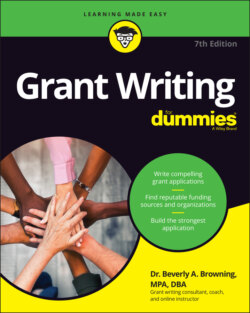Читать книгу Grant Writing For Dummies - Stan Hutton, Beverly A. Browning - Страница 71
Discovering direct grants
ОглавлениеThe advantages to applying for a direct grant award or cooperative agreement, which comes straight from the federal government, include the following:
Direct grants have no middlemen and none of the extra layers of red tape added by intermediary grantmaking agencies. You apply directly to the federal government for a grant in response to an announcement of the availability of funds.
When you compete for a direct grant, you communicate directly with a program officer in a division of a federal agency. This interaction means one-on-one attention, so be sure to review the application guidelines thoroughly and then compile all your questions. You can email or call the grantmaking agency’s contact person for clarification and answers. Doing so upfront clears the way for the topic research and the grantwriting process. Avoid being a nuisance! Don’t call and make small talk. Have your questions ready before approaching the agency contact and ask if the individual prefers to have questions emailed. Be prepared to take copious notes. If you feel you still lack a clear answer about how to proceed, ask again.Some federal agencies have a deadline for submitting questions via email or by phone; read the grant application guidelines to make sure you can still make the call or email contact. If the window has passed, look at the agency’s website for a link to frequently asked questions (FAQs). Others have probably asked the same questions you have, and the agency may have posted the answer for the general public to review. Also, remember to check daily for modifications to the initially posted grant applications guidelines.
Once you identify funding opportunities that you want to track, you can sign up for Grants.gov grants and receive email notifications when the application cycle opens for forecasted funding. In order to subscribe to those notifications, you need to register for an individual account (login and password required). Then just click Subscribe in the upper-right corner of the funding opportunities Synopsis tab.
Many federal agencies host a technical assistance call or webcast in which potential applicants can participate. In this forum, program staff members responsible for the grant application typically provide an overview of the application notice, highlighting key points of information, and then open the call to questions from potential applicants. These discussions provide a great opportunity to hear from program officers, ask questions, and learn from the questions of other applicants. You can find the date, time, and access information for any webinar in the full Notice of Funding Availability (NOFA) announcement, Request for Proposal (RFP), Funding Opportunity Announcement (FOA), or Request for Application (RFA), as well as on the funding agency’s program-specific website. It’s important to participate in these webinars to hear the full scope of what’s expected in a grant application recommended for funding.
Look for a link to the Full Announcement on the Related Documents tab in the View Grant Opportunity page (the same link you clicked to view the Synopsis). Figure 4-1 shows you what to expect when you’re on the Grants.gov site, perusing a NOFA, RFP, FOA, or RFA.
Source: https://www.dummies.com/business/nonprofits/grants/how-to-figure-out-differences-among-types-of-federal-grants/
FIGURE 4-1: How to figure out differences among types of federal grants.
The one major disadvantage to applying for a direct grant award is that they’re tough to win. You compete with other grant applicants from the 50 states and all the U.S. territories. If the feds are only planning to award money to ten grant applicants, your chances are slim — even with a stellar funding request. You may even be competing with state agencies, which further narrows your chances. Urban and rural poverty pockets receive first priority for most social-services-related program funding (such as housing, education, and health and human services) and other grantmaking areas earmarked for social-issue hot spots. If you aren’t proposing services in one of these high-needs geographic funding areas, your chances of winning a federal grant from a competition that gives 5 to 25 extra review points to high-needs, census-data-supported geographic areas are reduced to almost nothing. Not all funding programs have these types of service priorities.
